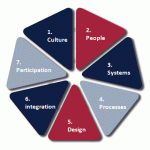Rolling Forecast can become the path leading to better company’s profitability and improved operating performance. This...
Introduction
 Within the finance professionals’ communities, there are regular discussions about what forecasting method is the most relevant. From Traditional Budget to Beyond Budget, through the Rolling Forecast, Scenarios, and Zero-Based Budgeting (ZBB), … influencers, consultants, and tool providers actively preach for their chapel. Furthermore, managers and business owners regularly express their disappointments about the process(es) in place (concerning accuracy, timeliness and workload in particular).
Within the finance professionals’ communities, there are regular discussions about what forecasting method is the most relevant. From Traditional Budget to Beyond Budget, through the Rolling Forecast, Scenarios, and Zero-Based Budgeting (ZBB), … influencers, consultants, and tool providers actively preach for their chapel. Furthermore, managers and business owners regularly express their disappointments about the process(es) in place (concerning accuracy, timeliness and workload in particular).
There are many business models and situations, probably as high as a million. In such an environment, it is then natural that the solutions put in place will cover a large spectrum, whether in the high-level principles or the specific implementation at the company level.
So, as a business professional, how can you evaluate the process(es) put in place in your company (or group of companies) and potentially evolve it in a way that effectively permits you to create value for your business(es)?
The forecasting “battlefield”
The process in place shall be consistent with its environment. The following elements must be assessed for the forecasting system to be evaluated and customised:
- The company market(s) characteristics.
- The company strategy, business model and situation.
- The company culture and its recognition systems.
Those elements evolve and may drive regular adjustments/changes in the forecasting process.
The market characteristics will influence the forecasting process profile in many ways (size and depth of the product, geographic, and customer dimension). Three are of particular importance in terms of methodology:
- The key 'from to' times (from proposal to order to revenues in particular).
- The type of revenues (recurrent versus none recurrent, project-based).
- Seasonality or not.
Those will drive the choices regarding forecasting rhythms based on the visibility window their combination offers. I.e., whether it shall be an annual, semestrial, quarterly, by projects or season, or a rolling process and whether this process will give a 12, 6, or 3 months perspective. In many companies, it is fully justified to have several parallel processes, each corresponding to a different business typology (with some yearly consolidation).
It also supposes an organised effort of business and competitive intelligence gathering on top of organising internal data management.
The company strategy, business model and situation are also determinants. The forecasting process(es) put in place shall support the strategy and business model (and not as seen in too many organisations, an autonomous/independent process that tends to supersede all the rest). Furthermore, the company situation may drive adaptation in the forecasting processes (high growth, survival, crisis such as war or pandemics).
The company culture and its recognition systems may be the more challenging to evaluate when you work from inside a company. A formal link from forecast to recognition can be a severe drawback in forecasting as it will largely enhance the decision-making biases that naturally pollute most organisations. Understanding and controlling (putting under control) those biases may be challenging depending on the company culture. See this article for more references.
Furthermore, the company management will expect the forecast process in 7 domains:
- Timeliness.
- Accuracy.
- Relevance.
- Transparency.
- Efficiency.
- Help with decision-making.
- Flexibility.
Those elements are interrelated, meaning evaluation shall be 360° (even if your processes are not entirely wrong).
An evaluation in five steps
- Draw the “battlefield” map (and its probable evolution).
- Confirm it with the business owners and company management.
- Perform a gap analysis (how the actual process fits with the map).
- Define the targeted process and the evolution that needs to be implemented.
- Confirm with the business owners and company management.
It will then be followed by an implementation project which may involve more or less important organisation, systems and data management changes.
The result of such evaluation can be extremely different from company to company, so here I can only give some typical situations.
The forecasting process in place is an annual budget covering all company activities, whereas the mapped drive for more differentiated solutions, i.e., a system based on the different key from/to times. Where the activities with immediate none recurrent revenues (say consumer/internet retail) are to produce Rolling Forecasts, the activities with recurrent revenues (say rental/maintenance contracts) are to make an annual or semestrial budget. Where seasonal activities are going through scenario season budgets and specific medium terms projects through project budgets or Rolling Forecasts depending on the type of projects, an annual budget would be highly criticised in such an extreme situation, and a differentiated system shall highly enhance the added value of the forecast process.
There is a lack of company expectation definition for its forecast process in terms of accuracy, driving major misalignments/misunderstandings. See this blog for more information.
The level of data granularity in the forecast may not be aligned with the business needs, seriously reducing the business owner’s ability to understand the forecast, say no customer/customer type dimension in the forecast (and generally in the reporting as well). It may concern product or geographic granularities.
Lack of proper business and competitive intelligence gathering and thus forecasts are potentially disconnected from the field reality. Statistical trends have their limits! Address the following article for more information.
In the presence of long or medium from/to times, orders and/or contracts are not properly accounted for and reported in a way that permits the objectivism of the forecast.
The build is based on wishful thinking top-down or “political” bottom-up without proper data backup!
There is insufficient data management discipline through the different systems.
All attention is spent on revenues, OPEX, headcounts and CAPEX per organisation units, largely discounting inventories, Cash Flow and Profitability (being global, per product, customer, or geographies when relevant).
There is too much rigidity and lack of flexibility in decision-making processes (whether in the budget or not) which drives some unnecessary demand for Rolling Forecasts. Check this blog entry for more information.
Summary
An in-depth evaluation of your forecasting process(es) needs to happen regularly, particularly when the actual process is going under pressure. The result of this evaluation will probably need some company-wide adjustments in the domain of external and internal data management and potentially in the domain of culture.
Subscribe to
FP&A Trends Digest

We will regularly update you on the latest trends and developments in FP&A. Take the opportunity to have articles written by finance thought leaders delivered directly to your inbox; watch compelling webinars; connect with like-minded professionals; and become a part of our global community.




